If you’ve ever brought milkweed into your gardens to help support the Monarch population, chances are, you’ve had to put up with aphids. These tiny, soft-bodies insects converge under the leaves of milkweed, line up the stems, and make your milkweed look like a super highway crammed with yellow taxi cabs. Aphids pierce the plant’s veins and suck out its life-giving juices. They’ll secret sticky honeydew that coats the leaves of your milkweed, robbing the leaves of their ability to absorb essential nutrient
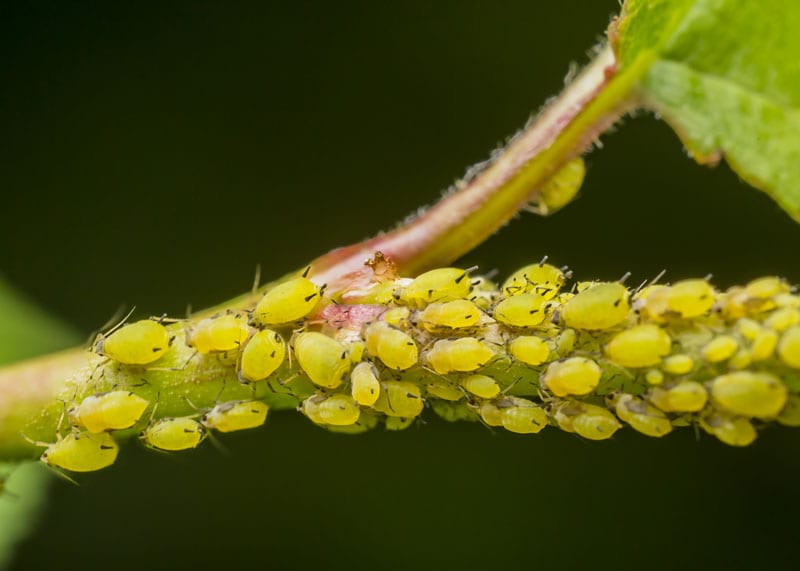

See what we mean by “super highway”? Aphids clone themselves at an alarmingly rapid pace, which is why early detection is crucial to rid yourselves of these little suckers!
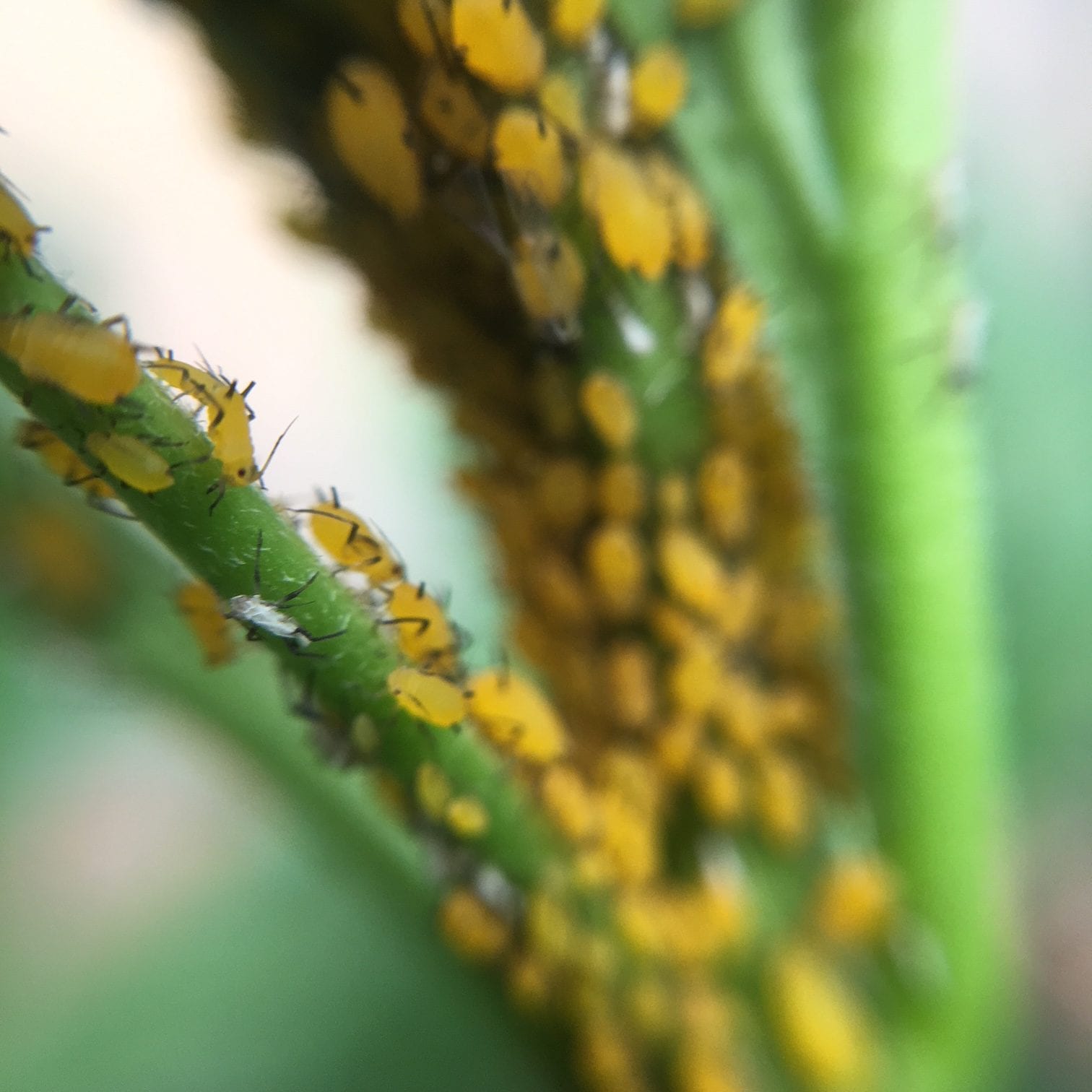

So what’s a Monarch butterfly lover to do when faced with these persistent pests that love to attack milkweed? It’s never advised to spray milkweed with any type of insecticide, even insecticidal soap can harm any stage of the butterflies life cycle. We think there are really two choices for pest control when it comes to treating milkweed for aphids: manual removal, and letting nature take its course.
A blast of water from the hose can knock the aphids loose and clean the honeydew layer off the leaves. Doing this once a week in the morning can do wonders for keeping aphids at bay and is most effective when aphid infestations are caught early (be sure to hit the underside of leaves). A blast of water is our #1 tip in the 4 Ways to Remove Pests Without Pesticides blog and we recommend this as a first attempt at pest control for other plants and pest issues too. However, although Monarch eggs are fairly securely attached, that hard blast of water could dislodge any Monarch eggs or larvae that are hidden on the bottoms of your leaves too! Thoroughly inspect your milkweed, rescue any eggs or caterpillars, and move them onto an uninfected plant, or to a protected location, like a netted butterfly pavilion.
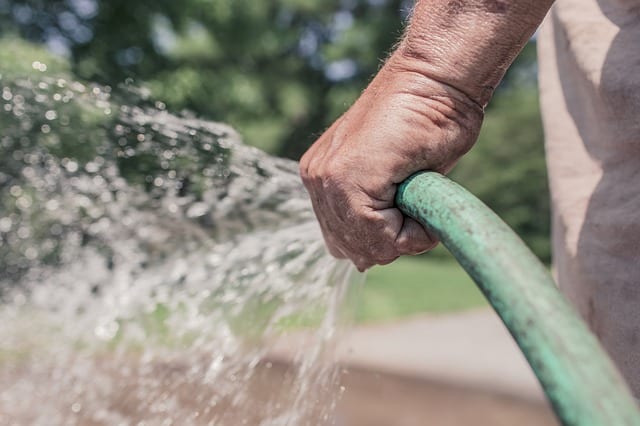

A blast of water removes aphids from milkweed but watch out for teeny, tiny, Monarch eggs attached under the leaves.


If you can relax a bit and let nature take its course, just about the time the milkweed starts blooming, and your milkweed looks overrun with aphids, beneficial insects like ladybugs, lacewing and their larvae show up to go to work. These beneficial insects have voracious appetites and aphids are one of their favorite meals. Ladybugs, Lacewings, and their larvae can clean up a milkweed plant overnight. You can hope for them to arrive, or employ some of our tactics to attract beneficial insects to your garden to better arm yourself in the battle of Aphids VS. Milkweed. *A note about ladybugs and lacewing larvae. They are beneficial insects and great destroyers of aphids, but during their feeding frenzy, Monarch eggs can get eaten too. Observe and inspect your milkweed often so you can rescue the eggs and baby caterpillars from any possible harm.


(What Lies Beneath!) Those aphids don’t know what they have coming for them. Lacewing eggs hanging and ready to hatch and larvae lies in wait under the leaves. Buh-Bye Aphids!
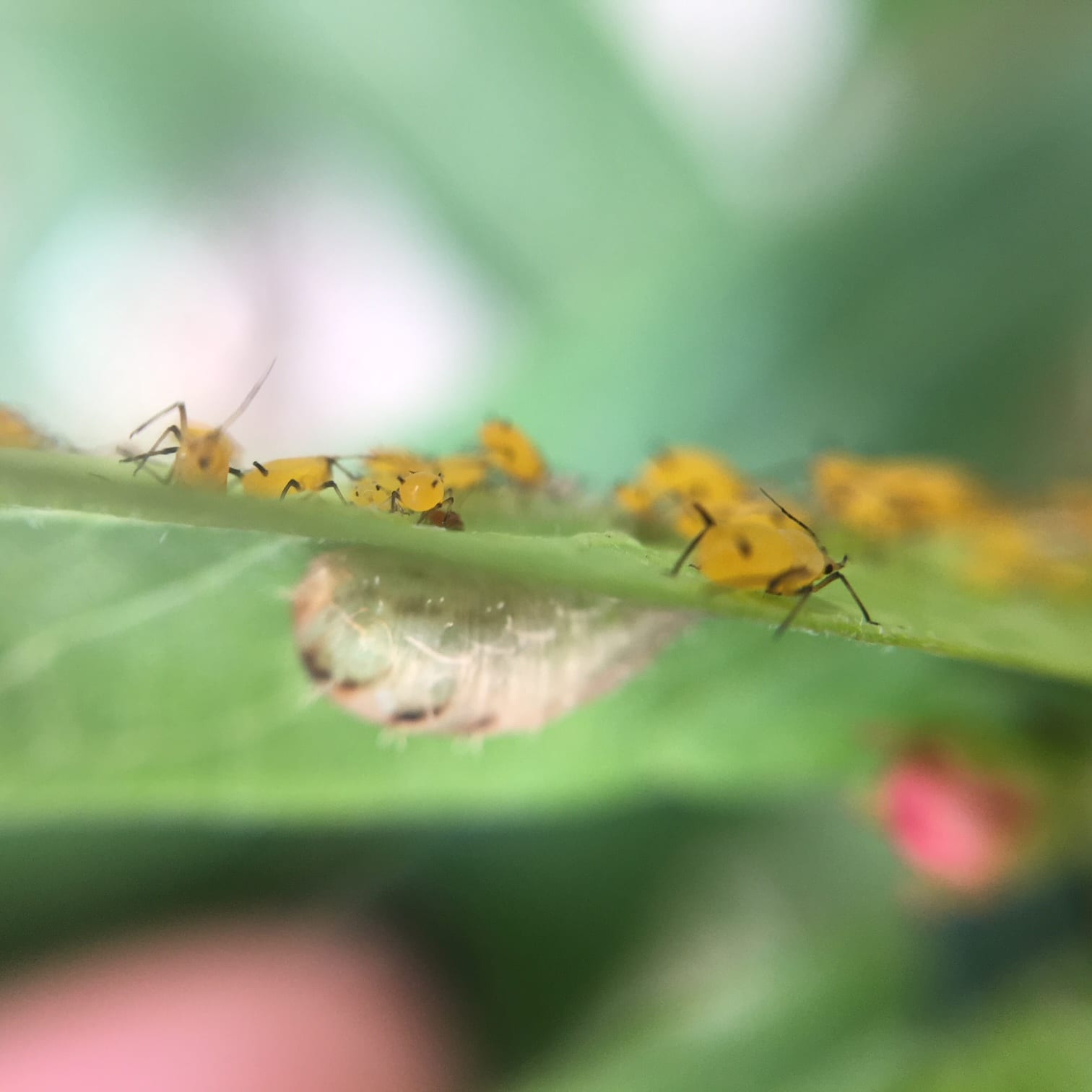

So what’s the bottom line here? Catch your aphids early and you won’t have to stress out as much, and….don’t stress out so much! Nature has a way of fixing things if we move out of its way a little. Keep planting milkweed, so you don’t miss out on the Monarch butterflies coming to your gardens, and don’t freak out too much about the aphids. As a matter of fact, if you see aphids on the milkweed at the nurseries, rejoice! It’s a sign of a pesticide-free plant! We NEVER treat our milkweed at Rainbow Gardens so when you purchase from us, your Monarch butterflies have a safe host plant to lay their eggs, a safe food source for their larvae to munch on and grow, and a safe nectar source for adult Monarchs to load up on much-needed fuel.
~The Happy Gardener

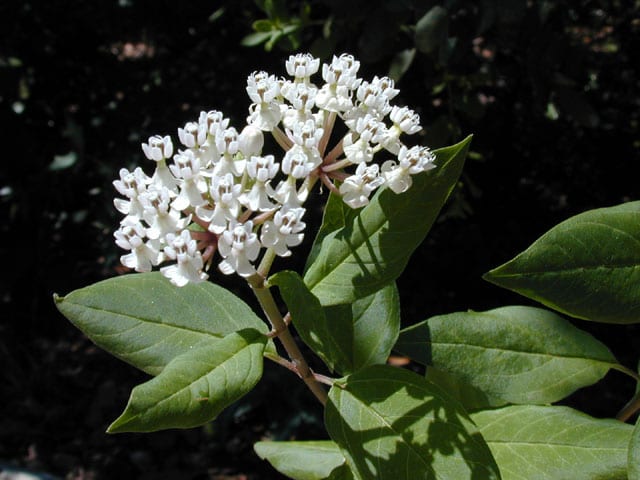
Since milkweed is a relatively fast growing plant perhaps just cutting it back to twelve inches with multiple branches remaining and strip all aphids off is best .
That will totally work too! I’ve done that a few times myself.
Can you you send lacewings? Would they go into the garden in the spring as the milkweed starts to grow? I had a horrible infestation and no monarchs this year due to aphids and then terrible flies.
Hi Carol,
Unfortunately we do not have lacewings at our garden center nor the current availability to ship products. I do believe there are companies out there that do ship lacewings. We have always found that they make their way into the garden naturally. I’m not sure where you live, but in San Antonio, Spring and fall temperatures are a good time to release lacewings. I’m attaching another good article about how to release the lacewing larvae should you be able to find some.https://www.insectary.com/portfolio-items/green-lacewing/
Hi Carol, I used to work at Nature’s Control, near Medford, OR. Many years ago small mom & Pop operation. They are a mail order business, also a nice little store. We had live ladybugs, green lacewing eggs.predatory nemetodes and more. Very knowledgeable people.im sure they will take care of you
Hi Patty,
Thanks for sharing and helping out a fellow gardener!
Remarkably enough, I have 4 beautiful caterpillars and they have stripped my milkweed clean! Do you guys have more plants available?
Hi Melissa,
As of today, both locations only had a very few quantity of Tuberosa milkweed. Hopefully we will get some more in a couple of weeks. I would go today to get the ones we currently have, and maybe call ahead and have them hold some for you since Friday and the weekends are busy.
Will do! Thank you!
Our local Home Depot Carry’s Milkweed. What a blessing.
Hi Sandra,
That’s wonderful! In time for the city’s fall pollinator migrations. Yay! Let’s hope they get it from an organic source so you can rest assured that they haven’t been treated with anything, and let’s hope they don’t treat it there. You can always ask.
Home Depots nursery plants as well as other big box stores..is imbedded w/ neonictonoid which is fatal to Pollinators…don’t believe me research…Bayer. neonictonoids..Friends of the Earth
Yes, you have to be careful. We vet our growers and bring in pesticide-free milkweeds. We always say, if you purchase a milkweed that has some amount of aphids on it, you’re good, because they wouldn’t be on there if pesticides were used. Ha!
Is purchasing lady bugs for aphid removal recommended?
Lacewings eat caterpillars and moths? Will they harm my butterfly caterpillars?
I’d like to order some lacewing eggs, but wonder.
Hi Mary,
Yes, lacewings can eat all types of caterpillars and butterfly eggs. If you are concerned or want to raise butterfly caterpillars, I’d suggest moving the eggs or caterpillars to an enclosure if you are going to use lacewings. Ladybug larvae can eat these too. A simple butterfly enclosure can protect the caterpillars while they grow big enough to be avoided by the beneficial predators. you can cut a piece of the plant that has the eggs or tiny caterpillars attached and stick the stem in some water along with a few other stems with leaves to feed the protected caterpillars for awhile.
I live in SW Florida and after buying about 50 milkweed plants I propagate need plants from cuttings or seeds. I check for caterpillars at least once a day and bring them into an enclosure. I feel that if the eggs and caterpillars are left in the “wild” only 10% will hatch into butterflies. I hand destroy the aphids once a day.
Oh wow! you are definitely a butterfly lover! Kudos to your hard work hand picking aphids!
Will milkweed get new leaves my caterpillars ate every one
Yes, milkweed will produce new leaves. (But more caterpillars will come to eat those too!) We encourage multiple milkweed plants in the landscape. Thanks for feeding the Monarchs!